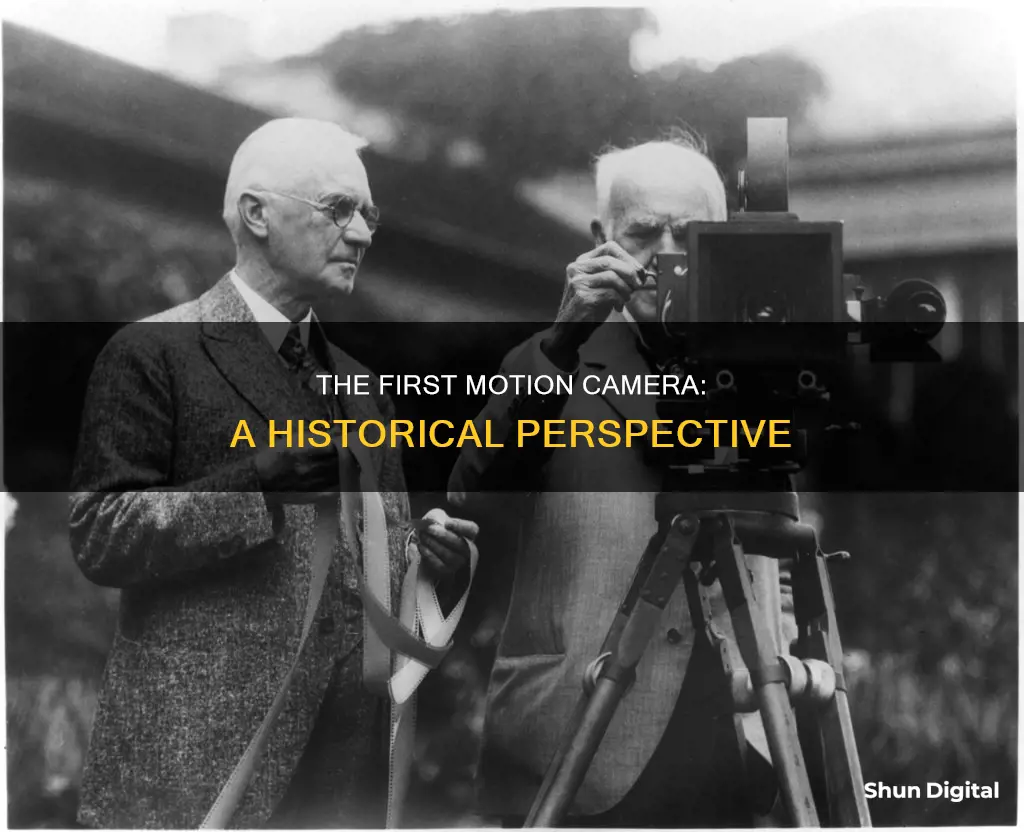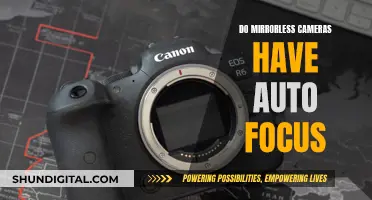
The history of the motion picture camera dates back to the late 19th century, with many inventors working on similar technology at the same time. The first motion picture camera was invented by Louis Le Prince in 1888. Le Prince's camera was a single-lens camera that captured the oldest surviving motion picture in the world, the Roundhay Garden Scene. However, Le Prince mysteriously vanished before he could screen the film, and Thomas Edison announced that he had invented a motion picture camera in 1891. The first camera to take motion pictures on a moving strip of film was the Kinetograph, invented by Edison's employee William Kennedy Laurie Dickson in 1891.
| Characteristics | Values |
|---|---|
| Year invented | 1888 |
| Inventor | Louis Le Prince |
| Film | "Roundhay Garden Scene" |
| Film length | 2 seconds |
| Film type | Silent, black and white |
| Camera type | Single-lens |
| Camera capabilities | 12 frames per second |
What You'll Learn

Thomas Edison's Kinetograph
Edison hoped to create a visual accompaniment for his phonograph, an early record player. In October 1888, he filed a caveat with the U.S. Patent Office to protect the future invention, describing it as an instrument that would "do for the eye what the phonograph does for the ear".
The Kinetograph was integral to the progress of motion-picture technology. It was a camera used to take a series of photographs of people or objects in motion. The processed film was passed rapidly between a viewing lens and an electric incandescent lamp inside a device called the Kinetoscope, creating the illusion of a moving picture for the viewer.
The Kinetograph could accommodate up to 15 metres (50 feet) of film at a time and could record at a rate of about 40 frames per second. The film moved through the camera by means of a sprocket system designed by Dickson. The sprocket teeth engaged two rows of holes running the length of the film along its edges. The images, or frames, recorded on the film were each 25 mm (1 inch) wide by 19 mm (0.75 inch) high.
The Kinetograph captured motion, and the Kinetoscope allowed people to view it. The Kinetoscope was an early motion picture exhibition device, designed for films to be viewed by one person at a time through a peephole viewer window. It was largely developed by Dickson between 1889 and 1892.
A patent for the Kinetograph was filed on 24 August 1891. The first public demonstration of the Kinetoscope was held at the Brooklyn Institute of Arts and Sciences on 9 May 1893.
The Revere Eight Model 88: A Camera's Cinematic Legacy
You may want to see also

Louis Le Prince's single-lens camera
The first motion picture camera was invented in the late 19th century, with several inventors credited with pioneering the technology. One of the key figures in the development of motion picture cameras was Louis Le Prince, who invented a single-lens camera in 1888.
Le Prince was born in Metz, France, in 1841 or 1842. He studied art and was friends with photographic pioneer Jacques Louis Mande Daguerre. In 1866, he moved to Leeds, England, to work as a manager at Whitley Partners, Engineers in Hunslet. He married into the Whitley family and started a photography business, where he began experimenting with moving pictures.
Le Prince's single-lens camera, also known as a 'receiver', was made of wood, metal, glass, and brass. The camera had two lenses at the front, with the lower lens used for taking pictures and the upper lens serving as a viewfinder. The lens assembly could be moved for focusing using a lever on the right. The camera body was crafted by a local joiner named Frederic Mason, while the metal parts were cast at Le Prince's father-in-law's firm, Whitley Partners, and fitted by his assistant, James W. Longley.
Le Prince patented his single-lens camera in 1888 and used it to film what is considered by some to be the earliest moving film footage in the world. He shot "Roundhay Garden Scene" and "Leeds Bridge" in October 1888, capturing moving picture sequences on Eastman paper film. He also filmed an accordion player in Leeds, though this footage has not survived.
Le Prince's invention played a crucial role in the advancement of cinematography, and he is regarded as an important figure in the development of moving pictures. However, his work was overshadowed by subsequent developments, and he mysteriously disappeared in 1890, never to be seen again.
Camera Batteries: Carry-on Essentials for Air Travel
You may want to see also

Eadweard Muybridge's zoopraxiscope
The first motion camera was invented in 1878 by Eadweard Muybridge, who set up 24 cameras linked to tripwires to take photographs of a horse galloping. This was the first movie ever made, and Muybridge later projected the images onto a screen using his invention, the zoopraxiscope.
The zoopraxiscope (initially named the zoographiscope and zoogyroscope) is an early device for displaying moving images and is considered a predecessor of the movie projector. Muybridge invented the device in the summer of 1879, with the machine built for him by January 1880. It projected his famous chronophotographic pictures in motion, proving their authenticity. Muybridge used the projector in his public lectures from 1880 to 1895, entertaining the public, creative professionals, and royalty.
The zoopraxiscope was a lantern that projected images in rapid succession onto a screen from photographs printed on a rotating glass disc, producing the illusion of moving pictures. Muybridge generally used painted sequences directly informed by his motion photography for his glass zoopraxiscope discs, with monkeys, kangaroos, dancing women, horses, and leapfrogging boys variously being animated. However, Muybridge also used motion photographs directly for disc images, including a horse skeleton.
Muybridge's zoopraxiscope amalgamated three existing visual technologies popular in the 19th century: photography, the zoetrope, and the magic lantern. While zoetropes and phenakistiscope had produced a sort of pictorial animation, the moving image could not be projected. Conversely, magic lanterns had been projecting images since the 17th century, but lifelike motion had not been achieved. Muybridge combined the animated illusion of movement from moving image toys with the projection capabilities of the magic lantern.
The zoopraxiscope was a pivotal moment in the history of the moving image, representing a missing link between slide projection and cinema. It served as one of the primary inspirations for Thomas Edison and William Kennedy Dickson's Kinetoscope, the first commercial film exhibition system.
Where is the Fujifilm X-T30 Camera Made?
You may want to see also

Etienne-Jules Marey's chrono-photography
The chronophotographic gun, invented by French scientist and chronophotographer Etienne-Jules Marey in 1882, was the first invention to capture moving images on the same chronomatographic plate using a metal shutter. It could shoot 12 images per second.
Marey's work was significant in the development of cardiology, physical instrumentation, aviation, cinematography and the science of laboratory photography. He is widely considered a pioneer of photography and an influential figure in the history of cinema.
Marey's interest in movement began with the study of blood circulation in the human body. He then shifted his focus to analysing heartbeats, respiration, muscles and body movement. To aid his studies, he developed many instruments for precise measurements, including the Sphygmograph, which measured the pulse.
In the 1880s, Marey adopted and further developed animated photography into a separate field of chronophotography. His revolutionary idea was to record several phases of movement on a single photographic surface. This was in contrast to the motion studies of Eadweard Muybridge, who depicted movement as a series of discrete moments on separate, sequential negatives. Marey's chronophotographic gun allowed him to study a variety of animals, including horses, birds, dogs, sheep, donkeys, elephants, fish, insects, reptiles and more. He also studied human locomotion, conducting a famous study about cats always landing on their feet.
In 1890, Marey published a substantial volume entitled "Le Vol des Oiseaux" ("The Flight of Birds"), which was richly illustrated with photographs, drawings and diagrams. He also created precise sculptures of various flying birds. In 1894, he published another book, "Le Mouvement".
Unlocking the S7 Edge: Exploring Camera Modes
You may want to see also

Auguste and Louis Lumiere's Cinematographe
The Lumière brothers, Auguste Marie Louis Nicholas (born 19 October 1862) and Louis Jean (born 5 October 1864), were French manufacturers of photography equipment. They are best known for their invention of the Cinematographe, a motion picture system, and the short films they produced between 1895 and 1905, which places them among the earliest filmmakers.
The Cinematographe was a three-in-one device that could record, develop, and project motion pictures. The original cinématographe was patented by Léon Guillaume Bouly on 12 February 1892, but the brothers further developed the device and patented their own version on 13 February 1895.
The date of the recording of their first film is in dispute. In an interview, Louis claimed that he shot the film in August 1894, before the arrival of the kinetoscope in France. However, historians question this, believing that a functional Lumière camera did not exist before the beginning of 1895. Their first film, 'Sortie des Usines Lumière à Lyon' ('Workers Leaving the Lumière Factory'), was likely recorded on 19 March 1895, the same year as their first screening. The film was approximately 46 seconds long when hand-cranked through a projector.
The Lumières held their first private screening of projected motion pictures on 22 March 1895, and their first public screening on 28 December 1895 at Paris's Salon Indien du Grand Café. This presentation featured ten short films, including their first, and is traditionally regarded as the birth of cinema. The Lumière brothers' Cinematographe was a breakthrough, with earlier filmmakers' techniques and business models proving less viable in comparison.
The brothers saw film as a novelty and had withdrawn from the film business by 1905, turning their attention to colour photography. They developed the first practical photographic colour process, the Lumière Autochrome, which was launched on the market in 1907.
Evolution of Casio Cameras: First Screens Unveiled
You may want to see also
Frequently asked questions
The first motion picture camera was invented in 1888 by Louis Le Prince.
Louis Le Prince was a French inventor who was born in 1841 in Metz, France. He grew up in a middle-class military family and studied the arts, optics and chemistry at university.
The oldest surviving motion picture in the world is the "Roundhay Garden Scene", a short film shot by Le Prince in October 1888.
Le Prince mysteriously vanished before he could screen his film in New York in 1890 as he had planned. He was officially declared dead on September 16, 1897.
A few months after Le Prince disappeared, Thomas Edison announced that he had invented a motion picture camera in 1891. Le Prince's family suspected that Edison had stolen Le Prince's ideas or was involved in his disappearance. However, most modern scholars assign Le Prince's employee, William Kennedy Laurie Dickson, with the major credit for the invention.







